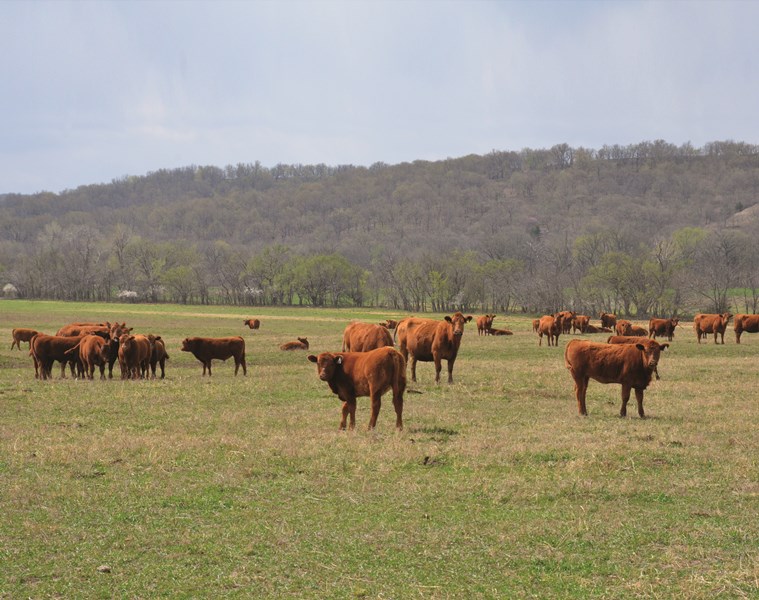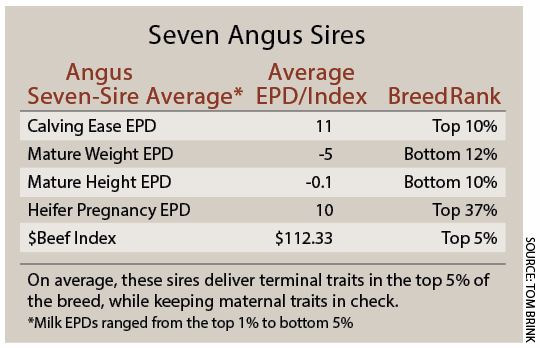Functional Cows, Premium Calves

Editors note: This is the second of a three-part series examining opportunities for beef producers to earn greater returns with high quality cattle.
Raising commercial cattle capable of earning high grid premiums presents a challenge for even the most experienced rancher. But the premiums available through today’s marketing grids make the effort time well-spent.
“Marketing programs and grids allow cattlemen to capture more value for their animals,” says Twig Marston, CEO, Red Angus Association of America. “They allow those cattle to find the dollars they are worth.”
Those top cattle are worth an average of $125 per head over the national average, according to a benchmark study released last month that identifies how to create the highest value for cattle. The study evaluated premiums earned by 15,164 high-quality cattle marketed on grids between 2011 and 2014. The data were evaluated by Tom Brink, owner of Top Dollar Angus, Inc., and Shawn Walter, Professional Cattle Consultants. Beef Today sponsored the study.
“With 70% of all fed cattle now marketed on carcass-merit grids and formulas, superior cattle now capture sizable premiums,” Brink says. “Feedyard managers are no longer surprised when some cattle earn a $50 to $75 per head premium on the grid/formula base price. With the right genetics and management, premiums that large and larger are not only possible, they occur every day.”
 | "Ranchers are finding the premiums they receive on these calves ring the bell." – Twig Marsten, Red Angus Association CEO |
While many have recognized the premiums available through grid marketing, some cow-calf producers are reluctant to reach for those top premiums for fear of the havoc it can create in their cow herd. Marston says today’s genetic selection tools allow ranchers to achieve both performance goals.
“Our Red Angus customers are happy on two fronts,” he says. “We’re producing the kind of cows with stayability traits for ranchers—high pregnancy rates and easy keepers. Our customers are also finding the premiums they receive on these calves ring the bell.”
Brink says it is possible to maintain a functional, range-adapted cow herd while simultaneously producing calves that excel in both the feedyard and on the grid.
“An adapted female is clearly the foundation of cow-calf profitability,” he says. “We need cows that maintain body condition and breed back on time year after year. However, added revenue and profit opportunity can be gained by building on that foundation through simultaneous selection of positive growth and carcass traits.”
Seedstock breeders, such as Jim Butcher of Gateway Simmental and SimmAngus in Lewiston, Mont., offer genetics with vastly improved predictability for desirable traits, allowing commercial customers to select for both carcass quality and maternal traits.
“We probably have more customers who retain ownership on their calves than most breeders up in this country,” Butcher said. “So our SimmAngus bulls are popular, but they also send really nice black heifers back into a commercial herd.”
For steers he sends to Nebraska for finishing, Butcher says his targets are 90% grading Choice, 50% qualifying for Certified Angus Beef and no Yield Grade 4s.
 |
Utilizing the available genetic tools and making wise selection and mating decisions, ranchers can build cattle that perform well in all areas of economic importance. |
With the right genetics, Brink says it is not necessary to consider maternal and terminal traits as an either/or proposition.
“By utilizing the available genetics tools and making wise selection and mating decisions, it is quite possible to build cattle that perform well in all areas of economic importance,” Brink explains. “Maternally-oriented cows producing calves genetically programmed to succeed in the rest of the beef supply chain? Yes, it can be done.”
Ken Conway has built a livelihood around the concept Brink describes. Through his Gene-Net integrated marketing alliance, Ken Conway has marketed nearly 1.5 million fed cattle and worked with more than 2,000 cow-calf producers, feedlots and seedstock producers throughout the U.S.
“Commercial ranchers realize their selection criteria are becoming more demanding,” Conway says. “But they have the selection tools today to be successful.”
Those selection tools, Conway says, makes the process more difficult but much more rewarding when those calves are marketed.
“To earn top grid premiums on a consistent basis, ranchers need to develop a relationship with their feed-yard,” Conway says. “They need to find a feedyard willing to sort cattle in order to market them correctly. That’s important to maximize grid potential.”
Brink offers hard data to support his belief that ranchers can have both maternal and carcass traits. He identified seven sires (see table above) selected from the Angus offering of a major AI company. Emphasis was placed on calving ease, moderate mature size and top shelf growth and carcass traits.
“The results are worth studying,” he says. “On average, these sires deliver terminal traits (captured by the American Angus Association’s $Beef index) in the top 5% of the breed, while ranking high for calving ease and holding mature cow size in check.”
Heifers by these sires would mature smaller than average for both weight and height. Their steer mates, however, would “go into the feed-yard and gain fast and efficiently before hanging up well above average carcasses. They would very likely earn a solid grid premium,” he says.
Additionally, Brink notes the seven bulls in his analysis offer milk EPDs ranging from the bottom 5% to the top 1% of the Angus breed. Along with moderate mature sizes and excellent terminal traits, daughter’s milking ability can be matched appropriately to available feed resources, whether scarce or abundant.
“Other breeds offer many of these EPDs,” Brink says. “So there is little need to sacrifice maternal ability for terminal traits, or vice versa. Creating cattle that perform on the ranch, in the feedyard and on the grind is fully within the reach of U.S. cow-calf producers.”
Avoiding Discounts
A key to earning top grid premiums is avoiding discounts. Tom Brink, owner of Top Dollar Angus, identifies four actions cow-calf producers can take to avoid carcass discounts.
- Create as much weight and frame-size uniformity as possible in groups sold off the farm/ranch. That can be accomplished through shorter calving seasons, standardized genetic inputs and sorting prior to when feeder calves are sold.
- Positive selection for marbling will help minimize the number of Standard grade carcasses.
- Selection for growth traits coupled with good nutrition and management allows calves and feeder cattle to reach acceptable market weights well before they run the risk of producing “aged” carcasses subject to discounts.
- Select and propagate good-disposition cattle. Docile cattle run a lower risk of producing dark cutting carcasses.








